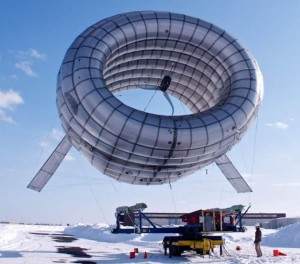Two Alums Dream of Tethered Aerostat Wind Farms
-
-
slice.mit.edu
- 2
Filed Under
Recommended
At first glance, it looks like a small blimp.

But floating 2,000 feet in the sky, Glass and Rein's product is actually an aerostat, or tethered balloon–the same kind that are used for lifting telecommunications or surveillance equipment high into the air. Within their giant, donut-shaped dirigible sits a wind turbine.
Last year, their dream to think outside the wind-farm box grew even bigger. Supported by MassChallenge and the MIT Venture Mentoring Service, Glass and Rein built a 60-foot diameter airborne wind turbine and launched it in the sky above Limestone, Maine.
The turbine captures many times more wind power than a traditional turbine, its creators say. It is also far cheaper and can be operated simply in remote locations that have no other power source, channeling wind energy back to the ground through its heavy-duty tether. One balloon-turbine unit can generate 30-100 megawatts of electricity, enough to power a small village.
Footage of the Altaeros test last year attracted hundreds of thousands of views, and now they are courting government, military, and private interests to scale up their design and make portable, airborne wind farms a reality. According to Glass, Altaeros is now at work on its first commercial-scale demonstration in Alaska.
“What we’re trying to do,” Rein said in a Reuters interview this May, “is instead of looking for where the sun or the winds are strong, bringing cheap renewable energy anywhere in the world where folks are having trouble getting renewable energy.”
The airborne turbine also solves the problem of building expensive offshore platforms, such as the ones required for the Cape Wind project currently in development.
“We’ve taken the approach of trying to design a system that will basically direct itself,” says Glass, who dreamed up the tethered turbine in his Energy Ventures Class in 2009. “Without any input or any control the aerodynamics of the system, just by the forces on the shroud and on the fins will direct it into the wind even as the wind direction changes.”
Many had doubts the turbine would work at first, but Glass and Rein, who partnered with Harvard Law student Alain Goubau, believed in their project. After seeing natural disasters like the earthquake in Haiti and the Fukashima Power Plant meltdown in Japan, their work has raised new possibilities. The turbine could be used in remote locations, or even above cities, when major power outages occur.
Update 3/21/14: Altaeros was awarded a $1.3 million grant by the Alaska Energy Authority for an 18-month test of its turbines. Read New York Times coverage of the project.








Comments
Adv. Suman Dash
Fri, 01/15/2016 9:56pm
Hello,
Mr.Benjamin, Mr.Adam and Mr.Alain first of all thank you for an Genius solution for Renewable Energy and Congratulation on an Award Winning State-of-the-Art Design.
However, it would be helpful if you Start up your Commercial Production early and at a Affordable price in order to Lighten up the World on Renewable Energy.
Awaiting your Early Reply
Regards
Adv Suman Dash
Oscar Hauptman
Fri, 09/27/2013 7:08pm
Hi alumni-innovators-entrepreneurs,
The idea was conceptually and quantitatively modelled circa 1980 in the Israel Institute of Technology (Technion) by Drs Kliatzkin and Mann in the faculty of aeronautics.
Cannot provide references.
Cheers!
Prof Oscar Hauptman